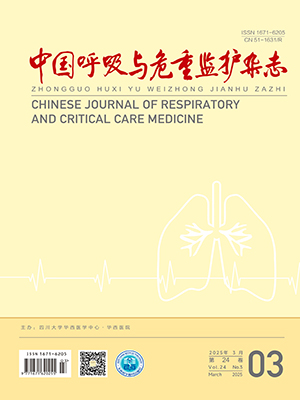Objective Using nerve growth factor ( NGF) and anti-NGF microspheres injected directly into the asthmatic rat adrenal gland, to explore the possible role of anti-NGF microsphere treatment in asthma.
Methods 32 male SD rats were randomly divided into a normal control group, an asthma group, a NGF microspheres group, and an anti-NGF microspheres group. The behavior of rats, lung function testing, light microscopy of lung biopsy, electron microscopy of adrenal medulla cell ultrastructure changes, NGF and phenylethanolamine N-methyltransferase ( PNMT) expressions in the adrenal gland were assayed by immunohistochemistry method, and serum NGF, cortisol, corticosterone, epinephrine and norepinephrine concentrations were detected by ELISA.
Results Behavior in the asthma rats showed varying degrees of sneezing, runny nose, wheezing, scratching the head and face, irritability holes, incontinence, increased aggression and other acts, while in the anti-NGF rats showed relatively slighter symptoms. The rats in the asthma, anti-NGF and NGF groups showed significant airway hyperresponsiveness, while RL value reduced and Cdyn value increased in the anti-NGF group compared with the asthma group. HE staining of lung tissue revealed obvious bronchoconstriction, inflammatory cell infiltration around small vessels and alveolar spaces and in interstitum, bronchial epithelial cells desquamation in the asthma group. In anti-NGF group, tracheal epithelium was relatively complete, inflammatory exudation, bronchoconstriction and inflammatory cell infiltration were milder compared to the asthma group. Electron microscopy showed vacuolated changes of adrenal medulla cells, uneven distribution of chromaffin granules in the asthma group and the NGFgroup, and the quantity and concentration of chromaffin granules were significantly lower than normal. There were villous clubbing processes on the adrenal medulla cell membrane in the NGF group. While the anti-NGF group had no significant vacuolar changes in chromaffin granules and the concentration was close to normal. Image analysis showed that mean gray values of PNMT and NGF in the anti-NGF group were significantly different fromthe asthma group. The ELISA results showed that: ( 1) The average concentrations of epinephrine in each group were as follows, ie. the control group gt; anti-NGF group gt; asthma group gt; NGF group. ( 2) The average concentrations of norepinephrine in each group were as follows, ie. the NGF group gt; asthma group gt; anti-NGF group gt; control group. ( 3) There was no significant difference among the groups in the average concentration of cortisol. ( 4) The average concentrations of norepinephrine in each group were as follows, ie. , the control group gt; anti-NGF group gt; asthma group gt; NGF group.
Conclusions Local embedding of anti-NGF microspheres can alleviate inflammatory infiltration in lung tissue and improve lung function of rat model with asthma. The mechanismmay be the anti-NGF antagonists the NGF receptor and reverse adrenal medulla cell transdifferentiation process primined by NGF.
Citation: LI Yuanyuan,HU Chengping,FENG Juntao,GU Haigang,DENG Pengbo,WANG Shengfeng,HE Ruoxi.. The Role of Local Embedding Intervention of Anti-nerve Growth Factor Microspheres in Pathogenesis of Asthma. Chinese Journal of Respiratory and Critical Care Medicine, 2013, 12(3): 293-299. doi: 10 . 7507 /1671 -6205 . 20130069 Copy
Copyright © the editorial department of Chinese Journal of Respiratory and Critical Care Medicine of West China Medical Publisher. All rights reserved
-
Previous Article
Protective Effects of Curcumin on Oxidative Stress-Induced Cell Injury in Human Fetal Lung Fibroblasts Co-cultured with A549 Cells and Its Mechanism WANGWenjun, ZHANG Deping. -
Next Article
Effects of Simvastatin on the Collagen Synthesis of Rat Pulmonary Arterial Smooth Muscle Cells Induced by Hypoxia LIUHaichao, HU Zhenhong, FU Zuhong.




